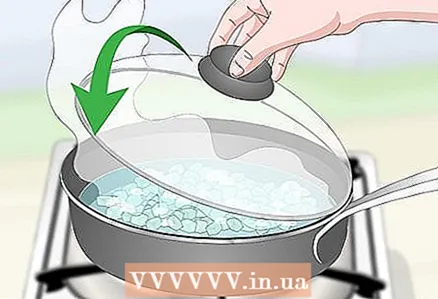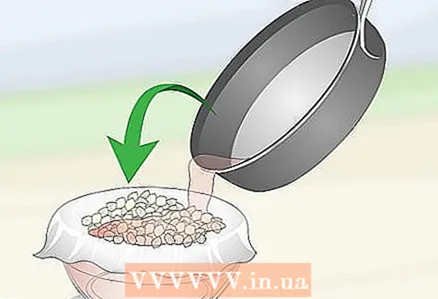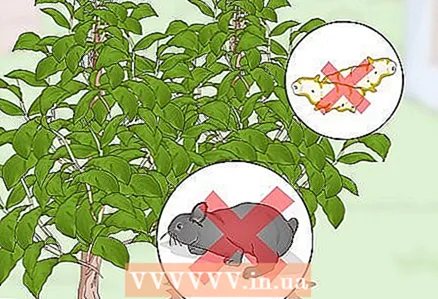
Content
- Ingredients
- Simple Garlic Spray
- Garlic, onion and chili spray
- Steps
- Part 1 of 3: Making a Simple Garlic Spray
- Part 2 of 3: Making a Garlic, Onion, and Chili Spray
- Part 3 of 3: Using the spray
- Warnings
Because of its flavor and nutritional value, garlic is widely used in cooking and can be beneficial for your garden. Garlic contains sulfur compounds, which makes it a natural repellent for many insects. This means that garlic can be used as a cheap and safe pesticide. A simple garlic spray will help get rid of aphids, slugs, and other insects, while an onion, chili, and garlic spray will scare away ladybugs, caterpillars, and even deer, as well as other insects and animals.
Ingredients
Simple Garlic Spray
- 1 head of garlic
- 4 cups (940 milliliters) water
- 2 tablespoons (30 ml) liquid soap
Garlic, onion and chili spray
- 4 cups (940 milliliters) water
- 1 head of garlic, peeled
- 1 small onion, peeled
- 1 teaspoon (2 grams) cayenne pepper powder
- 1 tablespoon (15 ml) liquid dish soap
Steps
Part 1 of 3: Making a Simple Garlic Spray
 1 Peel the garlic. Use your fingers to remove the outer rind from the head. Separate individual cloves and place them in a large metal bowl. Cover this bowl with another metal bowl of the same size. Press the bowls together and shake them vigorously for 10 seconds. Then remove the top bowl and remove the peeled garlic cloves.
1 Peel the garlic. Use your fingers to remove the outer rind from the head. Separate individual cloves and place them in a large metal bowl. Cover this bowl with another metal bowl of the same size. Press the bowls together and shake them vigorously for 10 seconds. Then remove the top bowl and remove the peeled garlic cloves. - If you don't have two identical metal bowls, you can use a large glass jar with a lid instead.
 2 Transfer the garlic to a blender. Place the garlic cloves in a blender. Add 1 cup (235 ml) water and cover the blender tightly. Stir the contents of the blender until the garlic is chopped (this will take about 1 minute).
2 Transfer the garlic to a blender. Place the garlic cloves in a blender. Add 1 cup (235 ml) water and cover the blender tightly. Stir the contents of the blender until the garlic is chopped (this will take about 1 minute). - If you don't have a stand blender, you can use a food processor or hand blender instead. You can also chop the garlic finely with a knife or crush with a garlic press and add water.
 3 Add the remaining water and soap to the blender. Stir still for about one minute, or until the garlic is dissolved. The soap will help the mixture adhere better to the plant leaves. Moreover, it is itself a pesticide.
3 Add the remaining water and soap to the blender. Stir still for about one minute, or until the garlic is dissolved. The soap will help the mixture adhere better to the plant leaves. Moreover, it is itself a pesticide. - Any liquid soap can be used, such as dish soap or castile soap.
 4 Leave the mixture overnight. Pour the resulting mixture into a glass jar and close it with a lid. Leave it at room temperature for 12-24 hours. The longer the mixture is infused, the better the sulfur compounds contained in the garlic will be absorbed into the water.
4 Leave the mixture overnight. Pour the resulting mixture into a glass jar and close it with a lid. Leave it at room temperature for 12-24 hours. The longer the mixture is infused, the better the sulfur compounds contained in the garlic will be absorbed into the water.  5 Strain the mixture. Line a fine mesh strainer with gauze and place on a bowl. Pour the mixture into a sieve to remove the garlic chunks. Squeeze the gauze lightly to squeeze out as much liquid as possible.
5 Strain the mixture. Line a fine mesh strainer with gauze and place on a bowl. Pour the mixture into a sieve to remove the garlic chunks. Squeeze the gauze lightly to squeeze out as much liquid as possible. - Straining is necessary to prevent the garlic chunks from clogging the spray nozzle.
 6 Pour the mixture into a spray bottle. Insert a funnel into the neck of a clean spray bottle and pour the prepared solution into it. After that, take out the funnel and put the cap on the bottle. Use the solution as needed to control pests and fungi in your garden.
6 Pour the mixture into a spray bottle. Insert a funnel into the neck of a clean spray bottle and pour the prepared solution into it. After that, take out the funnel and put the cap on the bottle. Use the solution as needed to control pests and fungi in your garden. - Store the solution in the refrigerator and use it within one week.
Part 2 of 3: Making a Garlic, Onion, and Chili Spray
 1 Chop the garlic and onion. Chop the garlic with a knife or crush with a press. Place the onion on a cutting board and cut it into small cubes with a sharp knife. Transfer chopped onions and garlic to a saucepan.
1 Chop the garlic and onion. Chop the garlic with a knife or crush with a press. Place the onion on a cutting board and cut it into small cubes with a sharp knife. Transfer chopped onions and garlic to a saucepan.  2 Add water and cayenne pepper to a saucepan. You can use paprika flakes or fresh hot peppers (such as jalapenos or habanero) instead of ground cayenne pepper. If you choose to use fresh peppers, chop them into small pieces before placing them in the pot.
2 Add water and cayenne pepper to a saucepan. You can use paprika flakes or fresh hot peppers (such as jalapenos or habanero) instead of ground cayenne pepper. If you choose to use fresh peppers, chop them into small pieces before placing them in the pot. - To enhance the properties of the pesticide, add 3-4 fresh or dry mint leaves to the pot as well. Mint repels ladybugs and other beetles.
 3 Boil the mixture. Cover the pot with a lid and bring the water to a boil over high heat. When the water boils, reduce the heat to medium so that it continues to simmer slowly for 15 minutes. Then remove the pan from the heat and set it aside.
3 Boil the mixture. Cover the pot with a lid and bring the water to a boil over high heat. When the water boils, reduce the heat to medium so that it continues to simmer slowly for 15 minutes. Then remove the pan from the heat and set it aside.  4 Let the solution sit. Leave the water with garlic, onion and pepper in a covered saucepan for 12-24 hours. During this time, oils and sulfur compounds contained in vegetables will be released into the water.
4 Let the solution sit. Leave the water with garlic, onion and pepper in a covered saucepan for 12-24 hours. During this time, oils and sulfur compounds contained in vegetables will be released into the water.  5 Strain the solution. Cover the sieve with gauze, place it on a bowl and pour the cooled solution into it.This will remove the chunks of garlic, onions and peppers, leaving you with a sprayable liquid.
5 Strain the solution. Cover the sieve with gauze, place it on a bowl and pour the cooled solution into it.This will remove the chunks of garlic, onions and peppers, leaving you with a sprayable liquid.  6 Pour the solution into a spray bottle. Place a funnel in a clean spray bottle and pour the solution into it to avoid splashing. Use the solution as needed to control pests and leaf-eating animals in your garden.
6 Pour the solution into a spray bottle. Place a funnel in a clean spray bottle and pour the solution into it to avoid splashing. Use the solution as needed to control pests and leaf-eating animals in your garden. - The solution can be stored in the refrigerator for about one week.
Part 3 of 3: Using the spray
 1 Spray plants to remove pests and powdery mildew. The garlic contained in the spray has antibacterial and antifungal properties and repels insects. Spray the leaves with garlic spray to treat many common problems. Garlic will help:
1 Spray plants to remove pests and powdery mildew. The garlic contained in the spray has antibacterial and antifungal properties and repels insects. Spray the leaves with garlic spray to treat many common problems. Garlic will help: - scare off aphids, slugs, caterpillars, ladybugs and other insects;
- to drive away deer, rabbits and other animals that can eat leaves from the garden;
- destroy powdery mildew.

Maggie moran
Home and garden specialist Maggie Moran is a professional gardener from Pennsylvania. Maggie moran
Maggie moran
Home and garden specialistYou can also make your own mosquito repellent with garlic. Gardener Maggie Moran explains how to do this: “You can put finely chopped garlic cloves in mineral oil. Soak the garlic chunks for 24 hours, then remove from the oil. Add 2 cups (470 ml) water and 1 teaspoon (5 ml) fresh lemon juice to the oil. Then strain the solution through a filter and pour it into a spray bottle. "
 2 Spray the leaves in the evening. Bring the spray bottle 15-30 centimeters to the leaves. Spray evenly on the top and bottom of the leaves. Many insects prefer to hide on the underside of the leaves, where powdery mildew can grow.
2 Spray the leaves in the evening. Bring the spray bottle 15-30 centimeters to the leaves. Spray evenly on the top and bottom of the leaves. Many insects prefer to hide on the underside of the leaves, where powdery mildew can grow. - It is best to apply the spray in the evening, when the sun cannot burn the leaves and the insects are more active.
 3 Spray the spray every few days and after rain. For best results, spray every 3-5 days (or every day) until the number of insects decreases. After that, continue to spray once a week. Also, spray after rain, as the rainwater will wash it off the leaves.
3 Spray the spray every few days and after rain. For best results, spray every 3-5 days (or every day) until the number of insects decreases. After that, continue to spray once a week. Also, spray after rain, as the rainwater will wash it off the leaves.  4 Wash vegetables and fruits thoroughly before eating. Although the garlic spray is non-toxic, you should wash the harvested fruits and vegetables thoroughly to remove any dirt from them. Garlic spray can be too hot and the soap can impart an unpleasant bitter taste.
4 Wash vegetables and fruits thoroughly before eating. Although the garlic spray is non-toxic, you should wash the harvested fruits and vegetables thoroughly to remove any dirt from them. Garlic spray can be too hot and the soap can impart an unpleasant bitter taste.
Warnings
- Be careful not to get the spray in your eyes, nose, or mouth, as it can cause a burning sensation, especially if you add hot peppers to the mixture.



